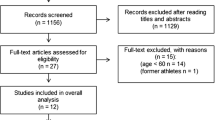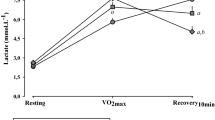Abstract
Large interindividual variation in maximal heart rate (HRmax) may not be accounted for by age alone. In order to evaluate a novel method in the prediction of HRmax, this study examined the profile of HR variability (HRV) during exercise in 40–67 years old men (n = 74). R–R intervals were recorded during supine rest and during a graded exercise test by cycle ergometry until exhaustion. A third-degree polynomial function was fitted to the HRV data recorded during exercise to represent the HRV profile of each subject. The instantaneous beat-to-beat R–R interval variability (SD1), high (HF) and low frequency power decreased between all consecutive exercise intensities (P < 0.033). The relationship between HRmax and a variable illustrating the declining rate of HF (HRHF50%) was stronger (r = 0.50, P < 0.001) than between HRmax and age (r = −0.36, P < 0.01). The regression analysis showed that a more accurate estimation of HRmax was attained when HRV was used in the equation in addition to age: HRmax = 160.633–0.603(age) + 0.441(HRHF50%) (SEE = 9.8 bpm vs. 11.6 bpm in the equation based on age alone). The decline of HRV during incremental exercise seems to be useful for accurate estimation of maximal heart rate.






Similar content being viewed by others
References
American College of Sports Medicine (2006) ACSM’s Guidelines for exercise testing and prescription. Lippincott Williams & Wilkins, Philadelphia
Åstrand PO, Bergh U, Kilbom A (1997) A 33-yr follow-up of peak oxygen uptake and related variables of former physical education students. J Appl Physiol 82:1844–1852
Åstrand PO, Ryhming I (1954) A nomogram for calculation of aerobic capacity (physical fitness) from pulse rate during sub-maximal work. J Appl Physiol 7:218–221
Balmer J, Potter CR, Bird SR, Davison RC (2005) Age-related changes in maximal power and maximal heart rate recorded during a ramped test in 114 cyclists age 15–73 years. J Aging Phys Act 13:75–86
Caputo F, Denadai BS (2004) Effects of aerobic endurance training status and specificity on oxygen uptake kinetics during maximal exercise. Eur J Appl Physiol 93:87–95
Cottin F, Lepretre PM, Lopes P, Papelier Y, Medigue C, Billat V (2006) Assessment of ventilatory thresholds from heart rate variability in well-trained subjects during cycling. Int J Sports Med 27:959–967
Cottin F, Medigue C, Lopes P, Lepretre PM, Heubert R, Billat V (2007) Ventilatory thresholds assessment from heart rate variability during an incremental exhaustive running test. Int J Sports Med 28:287–294
De Meersman RE (1993) Heart rate variability and aerobic fitness. Am Heart J 125:726–731
Fairbarn MS, Blackie SP, McElvaney NG, Wiggs BR, Pare PD, Pardy RL (1994) Prediction of heart rate and oxygen uptake during incremental and maximal exercise in healthy adults. Chest 105:1365–1369
Fernhall B, McCubbin JA, Pitetti KH, Rintala P, Rimmer JH, Millar AL, De Silva A (2001) Prediction of maximal heart rate in individuals with mental retardation. Med Sci Sports Exerc 33:1655–1660
Fleg JL (1986) Alterations in cardiovascular structure and function with advancing age. Am J Cardiol 57:33C–44C
Gamelin FX, Berthoin S, Bosquet L (2006) Validity of the polar S810 heart rate monitor to measure R-R intervals at rest. Med Sci Sports Exerc 38:887–893
Gellish RL, Goslin BR, Olson RE, McDonald A, Russi GD, Moudgil VK (2007) Longitudinal modeling of the relationship between age and maximal heart rate. Med Sci Sports Exerc 39:822–829
Gregoire J, Tuck S, Yamamoto Y, Hughson RL (1996) Heart rate variability at rest and exercise: influence of age, gender, and physical training. Can J Appl Physiol 21:455–470
Hautala AJ, Makikallio TH, Seppanen T, Huikuri HV, Tulppo MP (2003) Short-term correlation properties of R-R interval dynamics at different exercise intensity levels. Clin Physiol Funct Imaging 23:215–223
Holloszy JO, Coyle EF (1984) Adaptations of skeletal muscle to endurance exercise and their metabolic consequences. J Appl Physiol 56:831–838
Inbar O, Oren A, Scheinowitz M, Rotstein A, Dlin R, Casaburi R (1994) Normal cardiopulmonary responses during incremental exercise in 20- to 70-yr-old men. Med Sci Sports Exerc 26:538–546
Izquierdo M, Hakkinen K, Ibanez J, Kraemer WJ, Gorostiaga EM (2005) Effects of combined resistance and cardiovascular training on strength, power, muscle cross-sectional area, and endurance markers in middle-aged men. Eur J Appl Physiol 94:70–75
Jurca R, Church TS, Morss GM, Jordan AN, Earnest CP (2004) Eight weeks of moderate-intensity exercise training increases heart rate variability in sedentary postmenopausal women. Am Heart J 147:e21
Kingsley M, Lewis MJ, Marson RE (2005) Comparison of Polar 810s and an ambulatory ECG system for RR interval measurement during progressive exercise. Int J Sports Med 26:39–44
Kuipers H, Verstappen FT, Keizer HA, Geurten P, van Kranenburg G (1985) Variability of aerobic performance in the laboratory and its physiologic correlates. Int J Sports Med 6:197–201
Leicht AS, Allen GD, Hoey AJ (2003) Influence of intensive cycling training on heart rate variability during rest and exercise. Can J Appl Physiol 28:898–909
Lewis MJ, Kingsley M, Short AL, Simpson K (2007) Rate of reduction of heart rate variability during exercise as an index of physical work capacity. Scand J Med Sci Sports 17:696–702
Londeree BR, Moeschberger ML (1982) Effect of age and other factors on maximal heart rate. Res Q Exerc Sport 53:297–304
Maritz JS, Morrison JF, Peter J, Strydom NB, Wyndham CH (1961) A practical method of estimating an individual’s maximal oxygen intake. Ergonomics 4:97–122
McGuire DP (1986) The occurrence of an increase in correlation with explicit selection. Psychometrika 51:331
Melanson EL, Freedson PS (2001) The effect of endurance training on resting heart rate variability in sedentary adult males. Eur J Appl Physiol 85:442–449
Mikkola JS, Rusko HK, Nummela AT, Paavolainen LM, Hakkinen K (2007) Concurrent endurance and explosive type strength training increases activation and fast force production of leg extensor muscles in endurance athletes. J Strength Cond Res 21:613–620
Perini R, Milesi S, Fisher NM, Pendergast DR, Veicsteinas A (2000) Heart rate variability during dynamic exercise in elderly males and females. Eur J Appl Physiol 82:8–15
Pichot V, Roche F, Denis C, Garet M, Duverney D, Costes F, Barthelemy JC (2005) Interval training in elderly men increases both heart rate variability and baroreflex activity. Clin Auton Res 15:107–115
Robergs RA, Landwehr R (2002) The surprising history of the “HRmax = 220-age” equation. J Exerc Physiol 5:1–10
Sandercock GR, Brodie DA (2006) The use of heart rate variability measures to assess autonomic control during exercise. Scand J Med Sci Sports 16:302–313
Schiller BC, Casas YG, Desouza CA, Seals DR (2001) Maximal aerobic capacity across age in healthy Hispanic and Caucasian women. J Appl Physiol 91:1048–1054
Siconolfi SF, Cullinane EM, Carleton RA, Thompson PD (1982) Assessing VO2max in epidemiologic studies: modification of the Astrand-Rhyming test. Med Sci Sports Exerc 14:335–338
Stejskal P, Rechbergová J, Salinger J, Šlachta R, Elfmark M, Kalina M, Jurča R, Řehová I (2001) Power spectrum of heart rate variability in exercising humans: the effect of exercise intensity. Sports Med Train Rehab 10:39–57
Tanaka H, Monahan KD, Seals DR (2001) Age-predicted maximal heart rate revisited. J Am Coll Cardiol 37:153–156
Tschopp M, Peltola K, Held T, Kinnunen H, Hannula M, Laukkanen R, Marti B (2000) Traditionelle und neue Ansätze zur Schätzung der maximalen Sauerstoffaufnahme in Ruhe. Schweiz Z Sportmed Sporttraumatologie 48:58–63
Tulppo MP, Makikallio TH, Seppanen T, Laukkanen RT, Huikuri HV (1998) Vagal modulation of heart rate during exercise: effects of age and physical fitness. Am J Physiol 274:H424–H429
Tulppo MP, Makikallio TH, Takala TE, Seppanen T, Huikuri HV (1996) Quantitative beat-to-beat analysis of heart rate dynamics during exercise. Am J Physiol 271:H244–H252
Whaley MH, Kaminsky LA, Dwyer GB, Getchell LH, Norton JA (1992) Predictors of over- and underachievement of age-predicted maximal heart rate. Med Sci Sports Exerc 24:1173–1179
Yamamoto Y, Hughson RL, Peterson JC (1991) Autonomic control of heart rate during exercise studied by heart rate variability spectral analysis. J Appl Physiol 71:1136–1142
Acknowledgements
This study was partly supported by grants from the Ministry of Education, Finland and the Central Finland Health Care District, Jyväskylä, Finland, and by Polar Electro Oy, Kempele, Finland.
Author information
Authors and Affiliations
Corresponding author
Rights and permissions
About this article
Cite this article
Karavirta, L., Tulppo, M.P., Nyman, K. et al. Estimation of maximal heart rate using the relationship between heart rate variability and exercise intensity in 40–67 years old men. Eur J Appl Physiol 103, 25–32 (2008). https://doi.org/10.1007/s00421-007-0667-5
Accepted:
Published:
Issue Date:
DOI: https://doi.org/10.1007/s00421-007-0667-5




